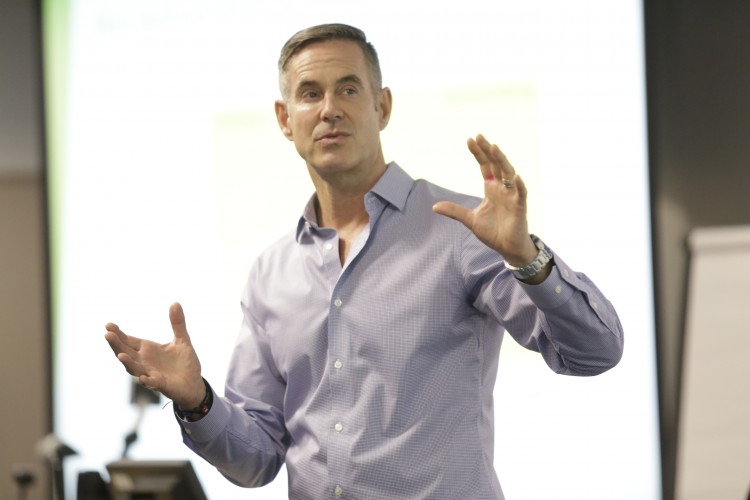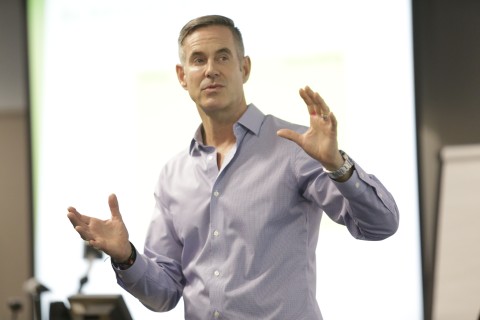
Custom Executive Education courses meet the needs of clients and appeal to all kinds of learners

When social distancing protocols meant in-person training was no longer possible, UBC Sauder took the custom Executive Education course it had created for a client online. The virtual classroom model UBC Sauder and Zymeworks developed was as close to in-person as it gets. Beyond the obvious perks of learning from home, there are surprising benefits to a virtual model.
Reinventing training for online
Biopharmaceutical innovator Zymeworks was set to engage UBC Sauder in a custom Executive Education course this spring, as it had been doing for several years now, when Covid-19 hit.
Social distancing protocols meant in-person training was no longer possible. But because Zymeworks is deeply invested in its employees and their professional development, David Porter, Director of Learning and Development at Zymeworks, was keen to reinvent the course for virtual delivery.
“We wanted to replicate the effectiveness of UBC Sauder Executive Education’s on-site training and take it online,” Porter says.
The UBC Sauder team collaborated closely with Porter and his colleagues to reinvent everything from the methods used to deliver the course, to the rules of engagement for its participants.
“This was not a watered down version of face-to-face, but rather an in-depth and rigourous multi-module program,” says Gavin Brown, Director, Custom and Executive Programs, Executive Education at UBC Sauder.
As close to in-person as online gets
The custom program was centred around managerial success in performance management. In its online iteration, it remained interactive and participant-oriented – video conferencing tools were used as a virtual classroom.
Markedly different from a webinar, which often consists of video lectures that learners watch independently, this virtual classroom was designed to be as live and in-person as online gets. Or in academic terms: synchronous rather than asynchronous.
UBC Sauder Adjunct Professor of Organizational Behaviour and Human Resources Rob Prowse taught the Zymeworks course.
“There are similarities between a webinar and a virtual classroom, but typically webinars don’t deepen skills, they deepen knowledge. People are actually involved in skill practice in a virtual classroom,” explains UBC Sauder Adjunct Professor of Organizational Behaviour and Human Resources Rob Prowse, who designed and delivered the virtual course.
In this course, participants moved between the main virtual classroom and smaller breakout sessions where they engaged deeply with their colleagues and had an opportunity to practice the skills they were learning.
“In training, you always have the option of being a passive learner and just listening,” says Porter. “But Rob [Prowse] has tremendous expertise and experience in drawing people out, making the training environment one where people are not only encouraged to participate but want to.”
Strengths of the virtual classroom
Even beyond the obvious perks, like being able to take the training from the comfort of your couch, a virtual classroom has many strengths.
“The access to the instructor might be even higher in a virtual classroom for people who have a more introverted learning style,” notes Prowse. “It allows people who tend to be deeper thinkers the time to be able to process their thoughts and participate in different ways than they otherwise might if we delivered face-to-face.”
This can mean more active participation from a greater number of participants.
“You get to hear more voices in a virtual classroom,” says Porter. “On site, regardless of the size of the audience, you typically have a handful of people who respond the most. In a virtual classroom, it offers different avenues for participants to engage.”
Similarly, the virtual classroom model enables Prowse to utilize a host of multimedia tools, thus maximizing interactivity.
“Between the main room, the breakout rooms, the chat function, the annotation tools and the non-verbal elements, participants appreciated the fact that there were many ways to engage and interact,” says Tonya Wagenaar, Learning and Development Associate at Zymeworks.
Ultimately, the effectiveness of the virtual classroom offers companies flexibility since it fits relatively seamlessly into a workday.
“If you’re running from meeting to meeting, it’s a lot easier to just jump into a training when it’s through a video conference,” says Porter.
Once social distancing protocols loosen, Prowse believes the option to deliver custom Executive Education courses online, or a hybrid of in-person and online, will be compelling to current and future UBC Sauder clients.
“Participant evaluations are as high for our custom virtual course as for face-to-face delivery,” reports Prowse. “When things open up again, many clients may choose to hold the first module in a face-to-face setting and then subsequent modules virtually.”
Customizing executive education for clients
At its core, UBC Sauder’s process for developing custom Executive Education courses and curricula is the same whether it’s being designed for an in-person or online delivery.
“First, we scope out the needs of the learning audience in terms of the desired knowledge, skill or behaviour,” explains Prowse. “Once we know what the desired performance is, we’re able to teach to the gap in an effective and relevant manner.”
In the course developed for Zymeworks – called Building Competency for Managerial Success in Performance Management – modules were centred around constructive feedback, goal setting and coaching skills among others.
“Participants enjoyed the opportunity to continue to train virtually amongst everything else that’s going on with COVID-19 and working from home one hundred percent of the time,” says Wagenaar. “Taking the virtual training helps maintain normalcy at work.”
